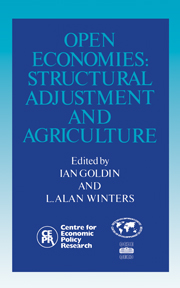Book contents
- Frontmatter
- Contents
- List of figures
- List of tables
- Preface
- Acknowledgements
- List of conference participants
- 1 Introduction: from macro to maize
- Part One Open economy analysis
- 2 Sequencing and welfare: labour markets and agriculture
- Discussion
- 3 Agricultural adjustment and the Mexico-USA free trade agreement
- Discussion
- 4 Do the benefits of fixed exchange rates outweigh their costs? The CFA Zone in Africa
- Discussion
- 5 Adjustment and the rural sector: a counterfactual analysis of Morocco
- Discussion
- Part Two The small country assumption and trade reform
- Part Three Risk and adjustment
- Part Four Government's role
- Index
Discussion
from Part One - Open economy analysis
Published online by Cambridge University Press: 04 August 2010
- Frontmatter
- Contents
- List of figures
- List of tables
- Preface
- Acknowledgements
- List of conference participants
- 1 Introduction: from macro to maize
- Part One Open economy analysis
- 2 Sequencing and welfare: labour markets and agriculture
- Discussion
- 3 Agricultural adjustment and the Mexico-USA free trade agreement
- Discussion
- 4 Do the benefits of fixed exchange rates outweigh their costs? The CFA Zone in Africa
- Discussion
- 5 Adjustment and the rural sector: a counterfactual analysis of Morocco
- Discussion
- Part Two The small country assumption and trade reform
- Part Three Risk and adjustment
- Part Four Government's role
- Index
Summary
Chapter 5 is yet another in the series applying the now famous ‘maquette’ – originally developed by Bourguignon, Branson and de Melo – to Morocco. Having seen most of the previous papers, I could not help feeling a sense of ‘déjà vu ’ in reading this one. Nevertheless, the framework is so rich that you learn something new every time it is applied. In discussion Chapter 2, Helmut Reisen likens Sebastian Edwards to a jazz musician, playing variations on a theme; in that vein, the Bourguignon- Branson-de Melo model is like a Mozart concerto.
The model is a multi-sector, multi-household, computable general equilibrium (CGE) model with some monetary elements. As it has been documented elsewhere, the authors do not dwell on the model's features in this paper; instead, they describe Morocco's adjustment experience and then highlight the impact of their counterfactual experiments on the rural sector. Their basic conclusions are: (1) that the functional distribution of income depends critically on changes in relative prices; and (2) that the changes in relative prices, in turn, depend on the particular closure rule chosen. These conclusions are reminiscent of the early work on CGE models applied to income distribution (Adelman and Robinson, 1979; Taylor et al., 1980). However, these early authors never looked at structural adjustment policies. The contribution of Bourguignon et al. here is to examine specific adjustment policies (trade liberalisation, interest rate liberalisation, etc.) in a distributionally-sensitive model. It is, however, reassuring that their conclusions about relative prices and closure rules are no different from those of the early authors on the subject.
- Type
- Chapter
- Information
- Open EconomiesStructural Adjustment and Agriculture, pp. 117 - 122Publisher: Cambridge University PressPrint publication year: 1992

